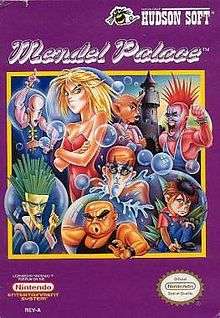Mendel Palace
| Mendel Palace | |
|---|---|
 North American cover art | |
| Developer(s) | Game Freak |
| Publisher(s) | |
| Director(s) | Satoshi Tajiri |
| Designer(s) | Satoshi Tajiri |
| Programmer(s) | Yuji Shingai |
| Artist(s) | Ken Sugimori |
| Composer(s) | Junichi Masuda |
| Platform(s) | Nintendo Entertainment System |
| Release date(s) | |
| Genre(s) | Action, puzzle |
| Mode(s) | Single-player, multiplayer |
Mendel Palace, originally released in Japan as Quinty (Japanese: クインティ Hepburn: Kuinti), is a 1990 action/puzzle arcade game developed by Game Freak. It was published in Japan by Namco[2] and in North America by Hudson Soft.[3] Mendel Palace was Game Freak's debut title, and the first game designed by Satoshi Tajiri,[4] who later worked on the Pokémon series.
Plot
The player's character must save his girlfriend, who was kidnapped by a young girl. The backstory differs slightly between the Japanese and American versions, although the in-game presentation is the same regardless. In the American version, the player's character is named Bon-Bon and the girl he must rescue is a Princess named Candy, who is trapped in her own dream. In the Japanese version, the main character is named Carton and the girl he must rescue is merely his own girlfriend, Jenny, who has been kidnapped by Carton's younger sister Quinty (the titular character in the Japanese version).
Gameplay
The game can be played by a single player, or by two players co-operatively. The players' characters are a blue and a green-colored boys in a vest and cap. Each level consists of a single room composed of a 5 by 7 grid of floor tiles surrounded by a boundary wall. At the beginning of each level a number of enemy dolls appear and start to wander around, attempting to collide with the player. The characters have the ability to "flip" the floor tile they are standing on or adjacent to in order to propel enemy dolls away, as well as revealing new floor tiles underneath. Enemies can be destroyed by flipping them into a wall or impassable block. The player(s) must destroy every doll to complete the level and move to the next one. It is also possible to win certain levels by making a "stalemate" in which all the tiles are unflippable like the bolted metal tiles or the graffiti tiles from the Artist dolls.
Each doll does a simple action that varies from each world. They vary from the basic walking motion to swimming and even aggressive tile flippers who have the same abilities to flip random tiles as the player. Touching an enemy causes the player to instantly lose a life. Each world has ten levels which is accompanied by a boss and a scene showing the player's girlfriend being whisked off to another part of the realm.
Stars and lives for each player are tracked separately on the screen. Some rooms are in darkness where players must anticipate useful tiles and enemies well in advance. If one player loses all of his lives, then the other player must continue to play until he also loses all of his lives.
Floor tiles
There are a variety of patterns on the floor tiles that can be collected or affect gameplay. Each particular tile can hide many patterns underneath that can be revealed after multiple flippings:
- Normal floor tiles that can be walked over or flipped.
- Star tiles can be collected by stepping over them. Collecting 100 stars earns the player an extra life. Collecting every star tile in a room will grant the player a bonus.
- Bonus roulette tiles.
- Shockwave tiles. This tile depicts a wave in one or more cardinal directions. When this tile is activated by stepping on it, it will flip over all tiles in that direction.
- Sun tiles. Activating this tile by walking over it will cause every other tile in the room to be flipped, usually defeating all enemies and clearing the stage.
- Moon tiles. Touching this tile will start a "bonus stage" where all floor tiles are replaced with collectible stars.
- Spinner tiles. This tile will shoot the player off in a particular direction, breaking blocks and destroying enemies that he touches.
- Impassible block tiles cannot be walked over by the player. These can be flipped to hide them and allow the player to pass.
- Bolted metal tile. Once this tile is revealed, it can no longer be flipped.
- Glowing portal tile. Once revealed, it will spawn a new enemy doll unless it is quickly flipped again.
Dolls
The level select screen shows each palace along with the enemy dolls that occupy it. Enemy dolls can be destroyed by flipping them into a wall or block, or by slamming into them from a Spinner tile.
- Clone dolls will split into two mini-dolls if flipped.
- Hopping dolls jump around crushing any blocks they land on. They can only be flipped in between jumps.
- Sumo dolls are heavy, and can flip tiles by stomping.
- Swimmer dolls begin offscreen and "swim" across, flipping tiles behind them.
- Ballerina dolls glide along diagonally, bouncing off walls and blocks.
- Artist dolls can graffiti a tile, rendering it un-flippable, or creating a doppelgänger enemy.
- Copycat dolls will mimic the player's movements and actions.
- Martial artist dolls will flip impeding block tiles or attempt to flip tiles you occupy (only found in the final palace).
References
- 1 2 Mendel Palace, GameFAQs.
- ↑ Japanese TV commercial of Quinty and Rasāru Ishii no Childs Quest.
- ↑ American TV commercial of Mendel Palace.
- ↑ Game Freak. "作品リスト". gamefreak.co.jp.
External links
- Complete credits for Mendel Palace at Tok2 (Japanese)
- Gameplay information for Mendel Palace at GeoCities.jp (Japanese)